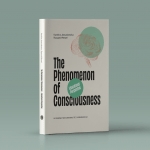Opis
The Phenomenon of Consciousness. Educational Perspective
Wydawnictwo Uniwersytetu Gdańskiego
Autor: Karolina Janczukowicz Ryszard Wenzel
The book considers some educational implications of the emergence of human consciousness. Part 1 sets out to define this phenomenon by analysing it from the perspective of memory and language in its individual and collective aspects. Part 2 shows several domains of human existence within which both progress and regress are constantly taking place. The educational implications taken up in each part of the book range from very practical didactic suggestions to broad theoretical and philosophical discussions.
The book is intended not only for a general audience, including teachers, students and researchers in all areas of the humanities, but also for scholars researching human development and evolution. No previous knowledge on the part of the reader of linguistics, psychology, theory of education or philosophy is required.
The book treats consciousness as an essentially evolutionary phenomenon; however it does not attempt to apply the features of biological evolution to conscious processes. Instead, it presents the emergence of consciousness as a turning point. From this moment on, evolution ceases to be a struggle for the biological survival of the fittest, and moves beyond it into the domains of cognition, creation and co-existence. The aim of education is understood in this context as a development of the intensity of consciousness, which means ensuring that humanity continues to progress rather than regress in terms of its consciousness.
Contents
Introduction . 7
Part I: Consciousness and its aspects . 11
Chapter 1. Procedural memory . 13
1.1. Three stages of procedural memory . . . . . . . . . . . . . . . . . . . . . . . . . . 14
1.2. Anoetic consciousness and procedural memory . . . . . . . . . . . . . . . . 17
1.3. Procedural memory – educational implications . . . . . . . . . . . . . . . . 20
1.3.1. Implicit and explicit learning . . . . . . . . . . . . . . . . . . . . . . . . . . 20
1.3.2. The educational implications of procedural learning . . . . . . 22
Chapter 2: Episodic memory and semantic memory . 26
2.1. Episodic memory: Remembering and failing to remember . . . . . . 29
2.2. Semantic memory and the cognitive structure . . . . . . . . . . . . . . . . . 32
2.2.1. Early concept formation . . . . . . . . . . . . . . . . . . . . . . . . . . . . . . 32
2.2.2. Higher mental processes . . . . . . . . . . . . . . . . . . . . . . . . . . . . . . 34
2.2.3. Higher language functions . . . . . . . . . . . . . . . . . . . . . . . . . . . . 37
2.2.4. The role of higher mental processes in semantic memory . . 39
2.3. Autonoetic consciousness and the self . . . . . . . . . . . . . . . . . . . . . . . . 40
2.3.1. The self and human motivation . . . . . . . . . . . . . . . . . . . . . . . . 41
2.3.2. Accompanying self-awareness . . . . . . . . . . . . . . . . . . . . . . . . . 42
2.3.3. Higher motivational drives in learning . . . . . . . . . . . . . . . . . . 43
2.4. Noetic consciousness and Umwelt . . . . . . . . . . . . . . . . . . . . . . . . . . . 44
2.4.1. The growth of noetic consciousness . . . . . . . . . . . . . . . . . . . . 46
2.4.2. Shaping the Umwelt . . . . . . . . . . . . . . . . . . . . . . . . . . . . . . . . . . 49
2.4.3. Phenomenal consciousness and access consciousness . . . . . . 50
Chapter 3: Language as a tool in creativity and cognition . 52
3.1. Empathy and the theory of mind . . . . . . . . . . . . . . . . . . . . . . . . . . . . 53
3.2. History as a collective aspect of consciousness . . . . . . . . . . . . . . . . . 56
3.2.1. Collective memory . . . . . . . . . . . . . . . . . . . . . . . . . . . . . . . . . . . 56
3.2.2. Communicative memory and historical awareness . . . . . . . . 59
6 Contents
3.2.3. Educational implications of historical awareness . . . . . . . . . . 61
3.3. Culture and art as collective aspects of consciousness . . . . . . . . . . . 63
3.3.1. Narrative . . . . . . . . . . . . . . . . . . . . . . . . . . . . . . . . . . . . . . . . . . 63
3.3.2. Metaphor . . . . . . . . . . . . . . . . . . . . . . . . . . . . . . . . . . . . . . . . . . 64
3.3.3. Educational implications: individual vs. collective goals . . . 68
3.3.4. Cultural awareness . . . . . . . . . . . . . . . . . . . . . . . . . . . . . . . . . . . 70
3.3.4.1. Cultural appreciation . . . . . . . . . . . . . . . . . . . . . . . . . . 70
3.3.4.2. Active participation . . . . . . . . . . . . . . . . . . . . . . . . . . . 72
3.3.4.2. Creativity . . . . . . . . . . . . . . . . . . . . . . . . . . . . . . . . . . . . 75
3.3.5. The growth of consciousness through art . . . . . . . . . . . . . . . . 79
3.4. Language and knowledge . . . . . . . . . . . . . . . . . . . . . . . . . . . . . . . . . . 81
3.4.1. Language awareness . . . . . . . . . . . . . . . . . . . . . . . . . . . . . . . . . 82
3.4.2. Conscious bilingualism . . . . . . . . . . . . . . . . . . . . . . . . . . . . . . . 85
Conclusions . 89
Part II: Evolutionary predictions . 93
Chapter 4: Phases of emergence . 93
4.1. The appearance of self-consciousness: Introductory phase . . . . . . . 95
4.2. The awakening of the spirit . . . . . . . . . . . . . . . . . . . . . . . . . . . . . . . . 95
4.3. Stagnation and decline . . . . . . . . . . . . . . . . . . . . . . . . . . . . . . . . . . . . 96
4.4. The revival of thinking skills . . . . . . . . . . . . . . . . . . . . . . . . . . . . . . 97
Chapter 5: The intensity of consciousness . 100
5.1. Domain of cognition . . . . . . . . . . . . . . . . . . . . . . . . . . . . . . . . . . . . . . 107
5.2. Domain of creation . . . . . . . . . . . . . . . . . . . . . . . . . . . . . . . . . . . . . . . 110
5.3. Domain of coexistence . . . . . . . . . . . . . . . . . . . . . . . . . . . . . . . . . . . . 112
5.4. Intensity of consciousness and education . . . . . . . . . . . . . . . . . . . . . 114
Chapter 6: Metaphysical inclination . 120
6.1. The presence of the absolute . . . . . . . . . . . . . . . . . . . . . . . . . . . . . . . 120
6.2. Metaphysical vs. supernatural . . . . . . . . . . . . . . . . . . . . . . . . . . . . . . 122
Chapter 7: The educational basis . 127
7.1. The underlying principles . . . . . . . . . . . . . . . . . . . . . . . . . . . . . . . . . 127
7.2. The practice of discussion and discovery . . . . . . . . . . . . . . . . . . . . . 133
7.3. Examples . . . . . . . . . . . . . . . . . . . . . . . . . . . . . . . . . . . . . . . . . . . . . . . . 140
Conclusions: Predictions on the direction of education . 147
References . 150











Opinie
Na razie nie ma opinii o produkcie.